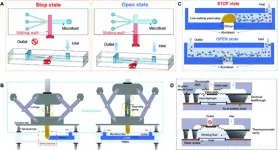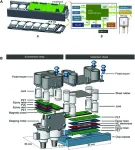The use of space environment to carry out life science research is of great significance to issues affecting the occurrence and development of life on earth by space flight and space environment; however, there are limitations in complex manipulation, research models based on mammalian and 2D cell culture experiments, and etc. Microfluidic chips, also known as "lab-on-chip (LOC)", integrates the related functions of traditional laboratories on a micron-level chip with low energy consumption, high throughput, and automation, which can realize long-term experimental operation, and remote data recording and transmission, thus overcoming the challenges of space environments, the scarce experimental resources, and the unmanned operation problems to some extent. To carry out related research with microfluidic chips, the actuation and control of microfluidics are very important. In a review paper recently published in Space: Science & Technology, researchers from Beijing Key Laboratory for Separation and Analysis in Biomedicine and Pharmaceuticals, School of Life Science, Beijing Institute of Technology, comprehensively discussed and summarized the progress of microfluidic actuated and controlled systems and the potential application and challenges in space science.
First of all, the current development of microfluidic actuated and controlled technologies is summarized. In the microfluidic chip, micropumps which plays the role of transmission and distribution of fluid flow are mainly divided into two categories, the mechanical micropump (acting on some structure of the chip) and the non-mechanical micropumps (directly driving the fluid). Mechanical micropumps transfer and control microfluids by the mechanical moving parts, representatives of which are diaphragm micropump, piston micropump, planetary gear micropump, pneumatic micropump, electrical-related micropump, piezoelectric micropump, and optically driven micropump, simple in design and operation but limited by film deformation and brittleness, complex fabrication process, high cost, poor reliability, and difficult integration. Non-mechanical micropumps rely on various physical or chemical effects to convert some non-mechanical energy into kinetic energy to drive the fluid, representatives of which are electroosmotic micropump, magnetohydrodynamic micropump, bubble-type micropump, capillary micropump, and surface acoustic wave (SAW) micropump, having a certain degree of stability during fabrication but requiring complex driving circuits, external equipment, and extra power during operation. The microvalve is a switch controlling element for fluid flow, which is usually located in the front of the system inlet node and channel node. Microvalve is divided into the active valve and passive valve herein. The active valve does not rely on the conversion of energy but directly acts on the switch of the fluid, such as the sliding wall and pinch valves. The passive microvalve is mainly affected by the action frequency of the pump chamber, to control the flow direction and pressure of the fluid such as phase change microvalve, hot bubble microvalve, and magnetic fluid microvalve. In recent years, increasing attention has been paid to combining different methods to overcome the shortcomings of a single mechanism-based microfluidic actuated or controlled.
Then, applications of microfluidic chips or systems under the simulating spatial conditions or some specific aerospace were briefly discussed. Under simulated microgravity, Michel et al. indicated that the all-glass LOC platform can be successfully implemented for culturing human keratin-forming cells and skin melanoma cells, Yang et al. found that at the early stage of seed germination, the growth factor response was significantly reduced after seed suspension, Wang et constructed analysis of microgravity damage on Cryptobacterium hidradenum, and Yew et al. developed a LOC clinorotation system to address the need for short-time tracking cellular responses and the establishment of dynamic fluidic environments. Some countries have successively carried out research projects in space life science based on microfluidic chips, such as the STS-116 mission (launching the first microchip capable of detecting Gram-negative bacteria in space), the "Foton-M3" spacecraft (low-Earth orbit tests), rHEALTH (designing a reusable microfluidic chip device called to monitor the health of astronauts during long flights in space), CubeSat (a significant validation not only of LOC systems but also of miniature variable g centrifuges operating in free-flying CubeSat), the first space organ-on-chip funded by the National Institutes of Health, BioSentinel (an example of autonomous bioanalytical Microsystems), and ISRO's modular Lab-chip payload. In the meanwhile, the research team has been conducting space life science research based on microfluidic chips for more than 10 years, and has successfully achieved several space launches. To sum up, space life science research requires highly integrated, automated, and functionally diverse detection platforms, and Microfluidic chips have unique advantages.
Moreover, application prospect of organ-on-chip in space life science is briefly discussed. Human microfluidic bionic organ-on-chip refers to a multi-channel 3D bionic microfluidic cell culture device that simulates the activities, mechanical characteristics, and related physiological reactions of the whole organ or organ system on a small chip through micro-processing. The development of organ-on-chip is towards multi-chip connection, highly integration and automation, so actuated and controlled systems have been used in microfluidic systems. In addition, as a revolutionary frontier biomedical technology, organ-on-chip has been included in the International Space Station plan by NASA.
At last, authors addressed that microfluidic actuated and controlled systems always play a central role, and more flexible design will provide more appropriate tools in space life science research.
Reference
Author: Yimeng Zhao, Xuefei Lv, Xiaoqiong Li, Nino Rcheulishvili, Yu Chen, Zhe Li, and Yulin Deng
Title of original article: Microfluidic Actuated and Controlled Systems and Application for Lab-on-Chip in Space Life Science
Journal: Space: Science & Technology
Affiliations: Beijing Institute of Technology
END




